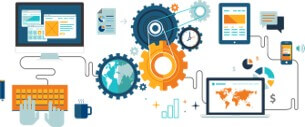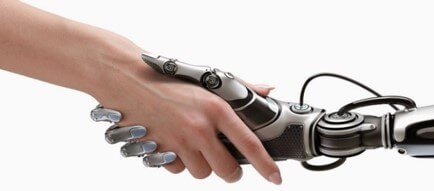
Would you like to start a conversation with other industry leaders to brainstorm a challenge or to just know more on a particular topic?
Engage in online discussions with your Peers
Start NowRobotic Process Automation (RPA) is a current topic generating immense anticipation and excitement. It is gaining momentum and promises a new ecosystem of intelligence that reshapes business and society. This will be agnostic to industries and will be the new phenomenon in BPM.
Volatile and unpredictable macro-environment has increased the complexity of doing business.
RPA is gaining momentum and promises a new ecosystem of
intelligence that reshapes business and society.
What’s controllable in organizations is something internal i.e. business processes, and a lot of this can be arrested by enterprises seeking to simplify their processes, improve the process efficiency & effectiveness and to manage their risk better. RPA offers improved business efficiency and effectiveness by emulating human actions and automating them even without making changes to the underlying systems and processes. It increases productivity, reduces cycle time, and improves accuracy and compliance.
The integration of basic automated business processes with cognitive practices leveraging higher automation/ artificial intelligence present a great opportunity to transcend all industrialized and commercialized processes for enhanced levels. Will they give absolute decisions? Obviously not! What they can provide are representative indicators, metrics with reference to previous events and patterns which help enhanced decision making. Following sections will discuss the potential evolution of Robotics and important aspects to make RPA successful.
Three Stages of Automation
-
Basic Process Automation: Solutions are not new to business and deliver ‘basic automation’ of manual tasks
-
Enhanced Process Automation: This involves unstructured data, multiple data, systems and knowledge bases
-
Autonomic/Cognitive: Solutions use sophisticated technologies involving cognitive machine learning, elements of AI, language processing and big data analytics. Organizations which are 10-15 years of shared services/ GICs will find their maturity model largely in the first two.
RPA for several will be a situation of Assess/ Evaluate now but automate gradually as RPA matures.
Opportunities/ Challenges to Adopt Robotics
The deftness (both breadth and depth of the process) at which many organizations can move to the 3rd level will be a function of 3 basic things:
-
Upstream Data Quality: One might automate, but if the data (e.g. core front-end capture systems) is a struggle it will impact downstream outputs. This is one of the big subjects on which regulators are coming in heavy directly or indirectly on GSIBs (Global Systemic Important Banks).
-
 Robustness of mapping the pattern of steps and structure of thought process adapted while reaching a judgment/ recommendation/ decision plays a key role. In this setting, automation algorithms need to work the way humans think; learning from experience.
Robustness of mapping the pattern of steps and structure of thought process adapted while reaching a judgment/ recommendation/ decision plays a key role. In this setting, automation algorithms need to work the way humans think; learning from experience.
Establishing the `R’ factor i.e. repeatability factor in process. It is quite logical that the more of this, deeper the automation and larger the benefits.
RPA is not a panacea. The inherent maturity of technology and
associated eco-system will evolve over a period of time, from
managing very basic data quality to superior process management….
The following can pose hurdles for RPA to penetrate both breadth and depth of processes
-
Vastly inconsistent or non-standard business processes that make broad automation impractical and will require investment and organizational changes
-
Disparate IT systems and a lack of integration across applications
-
Poor quality of services and expertise of RPA providers
-
Low organizational sponsorship, budgets and skills for business-process standardization ahead of RPA adoption and a reluctance to rationalize workforce as a potential direct benefit.
Technology as a Stake Partner
 Technology obviously has an important role to play. An ecosystem of expertise has to be in place to exploit diverse technologies, encompassing elements like big data, cloud, machine learning, integration with efficient workflow systems, data scrappers etc.
Technology obviously has an important role to play. An ecosystem of expertise has to be in place to exploit diverse technologies, encompassing elements like big data, cloud, machine learning, integration with efficient workflow systems, data scrappers etc.
Pulling all of this together requires cutting across traditional boundaries, and ideally using an end-to-end holistic approach. The key is to automate intelligently while balancing automated and human processes. To get it off the ground, this may require reliance on management by exception, which in turn requires strong governance and compliance check points.
There are studies showing RPA enhancing productivity by 10% to 40%. Other payoffs include enhanced accuracy, more flexibility and improved compliance. RPA’s additional direction of downstream analytics could well be predictive by collection of metadata. Processes can lend themselves by becoming more insightful and intelligent.
RPA is not a panacea. The inherent maturity of technology and associated eco-system will evolve over a period of time from managing very basic data quality to superior process management, appreciation of governance, automation tools and building a strategic organizational sponsorship to deal with imminent business issues. Based on the maturity yielded till date by industries, GICs and shared services over last 15 years plus, and learnings thereof, there is enough food for thought on how all organizational strategies for efficient BPM should be set. One of the key drivers is the evolving talent availability in the markets. Technology enables to be process dependent and efficient than people dependent – a good spot to be!!
Above all, organizational sponsorship from the right levels is very important for any progress to be made - and so is the case with Robotics.
ABOUT THE AUTHOR

Arun Mehra is Head – Business Finance, Global Finance Centers, HSBC. He has earlier worked with – American Express, Barclays Bank and Standard Chartered Bank. He has been in roles across Financial Controllership, CFO, Operational Risk & Policies, Shared Services and specialized areas of Transformation, Automation, Global Projects Management.




